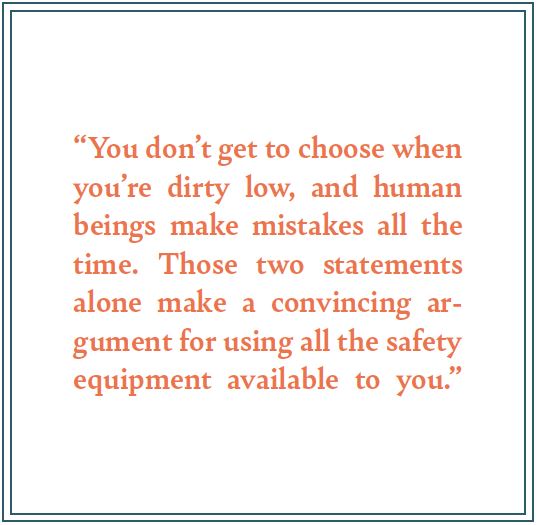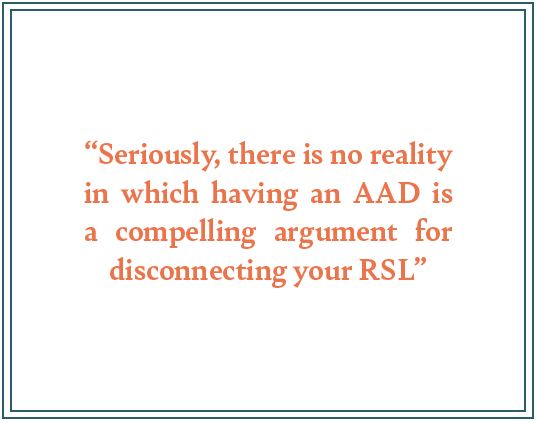What’s Your Excuse?
If you’ve been in this sport for a long time, there’s a good chance that you’ve lost friends who weren’t using a reserve static line or main-assisted-reserve-deployment device and made impact with the earth without an inflated reserve over their head. And if you visit a drop zone today, you’ll no doubt see lots of jumpers—many of whom are highly experienced and jump small canopies—who have disconnected their RSLS or MARDs (which are simply a type of RSL that uses the main canopy as a pilot chute).
It’s hard to quantify how many lives RSLs would have saved in the cases of fatalities due to cutaways with no reserve pulls. It’s also impossible to say how many lives RSLs have saved, since most jumpers don’t make a report when they land uneventfully under their reserves, even if they didn’t deploy them themselves. But it’s certainly in the hundreds, if not thousands.
Contrast that with the fact that since 1990, there has been only a single fatal incident attributed to an RSL. In that case, which occurred in 1997, a riser broke and the RSL deployed the reserve into the half-attached main. (Since then, riser designs have improved to the point where failure is almost unheard of.) That’s 26 years with only a single fatality attributed to an RSL, and even then, another piece of equipment was the ancillary cause.
Despite the fact that RSLs are proven life-savers, people still give many reasons for jumping without them. So, if you’ve disconnected this piece of equipment, what’s your excuse?
“I want to get stable after a cutaway before pulling my reserve ... ”
This is a common argument, stemming from a concern about spinning malfunctions, which are very common and can be quite violent and disorienting. It usually has one of three justifications:
“... because I want to deploy in a belly-to-earth orientation.”
Deploying belly to earth is ideal for your reserve deployment. And although it’s reasonable to be concerned about a clean reserve deployment when you’re on your back, altitude loss during a spinning malfunction should be a much larger concern. In his article “RSLs—Separating Fact from Fiction,” (January 2014 Parachutist), Jim Crouch provides the following information:
- Test jumpers took between 6 and 8 seconds to execute their cutaways once they decided they were required.
- Test jumpers who got belly to earth required an average of 6 seconds to recover stability after cutting away. (Remember, these are test jumpers who knew they were chopping on the jump.)
- Spinning canopies can lose hundreds of feet per revolution. (Bear in mind that a canopy can make one revolution per second when you’re in a spin, meaning that you’ll be losing altitude very quickly.)
Let’s look at a hypothetical scenario: You’re on a fun jump. You break off at 5,000 feet, track away for 5 seconds, deploy at 3,500 feet and saddle in at 2,800. You have spinning line twists and decide to cut away after three revolutions. (Let’s say, conservatively, you lost 200 feet per revolution.) That means you’re at 2,200 feet when you decide to chop. It takes you only 5 seconds for your cutaway procedures (you’re better than those test jumpers by 1 to 3 seconds, right?), in which time you make two more revolutions. So, you’re at 1,800 feet when you release your main. You take 5 seconds to get stable on your belly. (Less than the test jumpers, but they weren’t good flyers, right?) Since you weren’t at full freefall speed, you lose only 700 feet getting stable. Now, you’re at 1,100 feet. You pull your reserve and, for the purpose of this discussion let’s say it takes 300 feet to fully inflate. You’re saddled into your reserve at 800 feet.
If you’re a skilled BASE jumper, perhaps 800 feet sounds OK. To me, it sounds insane.
What if your reserve doesn’t inflate in 300 feet? (It probably won’t. A lot of people believe their reserve must open in this distance because they heard that’s what the Federal Aviation Administration’s Technical Standard Order requires, but these tests are done in far different conditions than on actual skydives. In short, don’t bet your life on a 300-foot reserve deployment). What if you make more than three revolutions before deciding to chop? What if your handles have shifted from their expected locations because of the force of the spin? What if the release of those forces means your reserve handle shifts again? What if your canopy loses more than 200 feet per revolution? (Sub-100-foot canopies will almost certainly do so.) What if you fought the twists because they didn’t look too bad, but then the spin increases and your chop is later and lower? How many of these what-ifs are likely to happen during an emergency?
The most insidious problem with the logic of, “I want to get stable before I deploy my reserve,” is that sometimes you’ll be dirty low. Which brings us to a very important what-if: What if the emergency doesn’t start at your normal pull altitude?
Let’s look at two real-life situations that had very different outcomes. In one, a highly experienced professional canopy pilot collided with a lower jumper after making a large turn to land. The impact—which destroyed the swooper’s very high-performance canopy—occurred at about 400-500 feet. The situation was very stressful and fast-moving, which is likely why she reverted to the emergency procedures she knew best rather than going straight to the reserve to get fabric above her head. She chopped immediately and deployed her reserve very soon afterward but hit the  ground at reserve line stretch. She had disconnected her RSL (as many swoopers then did), and MARDs weren’t available on her model of rig at that time. She died instantly.
ground at reserve line stretch. She had disconnected her RSL (as many swoopers then did), and MARDs weren’t available on her model of rig at that time. She died instantly.
It’s impossible to say whether an RSL would have prevented her death or even helped much, since she was so low, was traveling so quickly and performed her EPs right away. However, her RSL probably would have been slightly faster than she was, and had it been connected, she would at least have had a chance. A MARD would have been even faster, and all she needed, according to a credible witness, was an extra 100 feet.
In contrast is the story of another highly experienced skydiver. This jumper, who usually didn’t use an RSL/MARD when swooping, was competing at a canopy piloting meet and had the chance to fly a prototype canopy for the first time. He hooked it up for round one and initiated his final turn to the course using the inputs he always used with his usual canopy. Unfortunately, they were the wrong inputs for the prototype, and the canopy folded in half about halfway through the turn, putting him into a spin on his back. He cut away less than 2 seconds later, at an estimated 600 feet. Those on the ground thought he didn’t have time to get a reserve out … they thought he was as good as dead. But his MARD—which he had wisely hooked up that morning since he was flying a prototype canopy—opened the reserve at lightning-fast speed. He had a half twist in his lines that he cleared almost immediately and even had time to make one turn to a safe landing.
What do these stories, with totally different outcomes, have in common? They were both professional skydivers with tons of training who had a good main canopy to start, but both eventually needed to chop. This brings us to the two salient points: You don’t get to choose when you’re dirty low, and human beings make mistakes all the time. Those two statements alone make a convincing argument for using all the safety equipment available to you. They give you the best possible chance to survive your mistakes (or possibly, the mistakes of others).
If you decide to get stable before deploying, you should acknowledge that you’re implicitly saying that you’re not going to make any mistakes that put you low, no one around you is going to make a mistake that puts you low and you’ll have enough altitude on 100% of your chops to get stable and deploy your reserve before you impact the earth. That’s not a very convincing argument.
“ ... because I don’t want to have line twists on my reserve.”
This is really a more-specific extension of the argument about being belly to earth, since if you’re going belly to earth, it means you’ve stopped spinning (though not necessarily). During a spin, your feet generally have a faster rate of turn than your head. If you cut away and pull your reserve while you still have this momentum, you introduce twists into your reserve lines. The argument here is that the speed at which the RSL/MARD deploys the reserve means that your spinning energy will translate into line twists.
On the surface, this argument seems compelling. You were just in a hectic situation, and having line twists on your reserve will also feel hectic. However, your reserve is designed to fly flat and stable. It will very likely fly that way even with a bunch of twists. Your reserve wing loading is almost certainly lighter than your main’s, meaning the reserve will perform better in any possible malfunction situation. Your RSL/MARD got your reserve out quickly, meaning you have more altitude (and therefore more time) to deal with the twists. And finally, even if the reserve above your head has line twists, you’ll very likely have a survivable landing. If you use up that precious altitude getting stable, you might not have anything above your head at all.
The reality is that during a spinning malfunction, you are in the greatest need of an RSL/MARD, since the spinning forces can shift the position of your cutaway and reserve handles, making your cutaway procedures take even longer than you expect and wasting time and altitude … time and altitude that you might need soon.
As the sport transitions to MARDs from traditional RSLs, the fear of reserve line twists is sure to wane. MARD deployments are crazy fast, not even allowing enough time for full arm extension while pulling the cutaway cable before a fully inflated reserve is overhead. Line twists can still happen, but there will be fewer than with an RSL since the time it takes the reserve to deploy is so much shorter. With its speed, MARD technology provides the best possible chance to survive the widest variety of emergencies.
“ ... because I don’t want to tumble through my lines.”
Years ago, competitive swoopers argued that multi-axis tumbles were a new problem due to the small and super-aggressive nature of some modern canopies. Talk of the possibility of tumbling through lines has since faded, mostly because there’s little to no evidence of this happening, but in case the idea is still circulating, here we go.
The idea is that a muti-axis tumble may occur due to momentum, similarly to how a body’s momentum can contribute to reserve line twists. However, for this to happen, your canopy would have to be alternating between being above you at one moment and below you in the next (something like a paraglider pilot who spins the canopy in a full vertical loop around their body), which would cause your momentum to propel you through the reserve lines once the main releases and the RSL/MARD deploys the reserve. It may not be impossible, but it seems highly unlikely. And USPA has never had a report of this happening.
“I have an AAD; I don’t need an RSL/MARD.”
Folks, this is just patently false. Automatic activation devices and RSLs/MARDs operate entirely differently and are useful in entirely different situations. AADs are most effective for freefall emergencies, such as getting knocked unconscious. They are not designed for use in canopy emergencies, which is where your RSL excels.
 In order to activate, an AAD must be traveling at a certain speed below a certain altitude. These altitudes and speeds vary by brand and model, but are usually something like “activates at 78 mph or more below 1,000 feet AGL.” Because of these parameters, your AAD does not represent a good option during a canopy emergency. Once you’re under canopy, your vertical descent has slowed considerably (even under a spinning malfunction). In order to activate, your AAD has to sense that you’ve sped back up to the minimum firing speed, which will take some number of seconds and again waste altitude that you might want back very soon.
In order to activate, an AAD must be traveling at a certain speed below a certain altitude. These altitudes and speeds vary by brand and model, but are usually something like “activates at 78 mph or more below 1,000 feet AGL.” Because of these parameters, your AAD does not represent a good option during a canopy emergency. Once you’re under canopy, your vertical descent has slowed considerably (even under a spinning malfunction). In order to activate, your AAD has to sense that you’ve sped back up to the minimum firing speed, which will take some number of seconds and again waste altitude that you might want back very soon.
There’s also a logical disconnect with this argument. On the one hand, the argument seems to be that you don’t want to allow this RSL/MARD device to open the reserve for you despite the fact that you’re probably still quite high above the earth, the reason being that problems may ensue, even though you’ll have lots of time to deal with those. On the other hand, this argument says it’s fine to let this computer open your reserve for you, possibly having to wait for your speed to build back up at an incredibly low altitude where you have less time to deal with any problems that ensue (if you even get a reserve overhead in time).
If this is your reason for not using your RSL/MARD, and this section doesn’t convince you, please seek out someone you trust around the DZ to discuss it further until you are convinced. Seriously, there is no reality in which having an AAD is a compelling argument for disconnecting your RSL.
Are there any times in which disconnecting an RSL/MARD makes sense?
There are! But there are only three.
1| You’re doing canopy formation skydiving (aka CRW or canopy relative work)
2| You’re canopy flocking
3| You’re getting air-to-air coaching in a canopy course
That’s it!
These fun and challenging ways to fly your canopy are similar in that you’ll be intentionally flying in close proximity to other canopies, and if there’s a wrap and you need to cut away, you don’t want your reserve canopy to fire into that mess. (In CF particularly, there’s intentional contact between canopies or jumpers, and if you do it enough, it’s not a question of if you’re going to have a canopy wrap but when.) Wrap situations require great communication, a never-give-up attitude and the ability of one or both (or all ... it could be a big wrap!) jumpers to release their mains and fall away before deploying a reserve. In wrap scenarios, your connected RSL or MARD could worsen the wrap into something you cannot extricate yourself from, so disconnecting them is a good choice here.
Final Thoughts
If you’re considering disconnecting your RSL/MARD (or you already did), hopefully you’ll give the facts in this article some serious thought. If you’re a young jumper and someone you look up to has their RSL/MARD disconnected, please don’t mimic their behavior. The skydiving community has been deprived of some incredibly talented skydivers—likely far more talented than that hometown hero—because of that same choice. And if you’re a good swooper or are otherwise influential around the DZ, take a second to think about how your decisions could potentially influence younger jumpers into mimicking your behavior.
Finally, if you see a person with a disconnected RSL/MARD, don’t assume that they’ve read this article or the previous articles or have done any thinking about it at all. Have a polite conversation with them about that choice. Try some gentle education, or if it’s easier, direct them to this article or January 2014’s “RSLs: Separating Fact from Fiction” under the Back Issues tab at parachutist.com. It may be a tough conversation, and it may make them defensive, but give it a shot anyway. A little education can go a long way, and your simple efforts can pay some big dividends to that person’s future.
USPA anonymized the two incidents the author discussed in this article. However, it’s important to note that these were not hypothetical events. They involved real people who were friends of the author. In one of those incidents, his friend died. In the other, his friend survived. His hope to have more stories like the second one provided his motivation for writing this article.
 About the Author
About the Author
Jason Russell, D-27326, started skydiving in 2002 and has since made almost 21,000 jumps. He’s earned 27 national and world vertical formation skydiving championships, both indoor and outdoor. He regularly organizes at Skydive Chicago in Ottawa, Illinois, and Skydive Sebastian in Florida. He’s also an accomplished big-way organizer and was part of the organizing team during the last two Fédération Aéronautique Internationale World Records for Largest Head-Down Formation Skydive, as well as the recent 200-way head-down world record attempts.